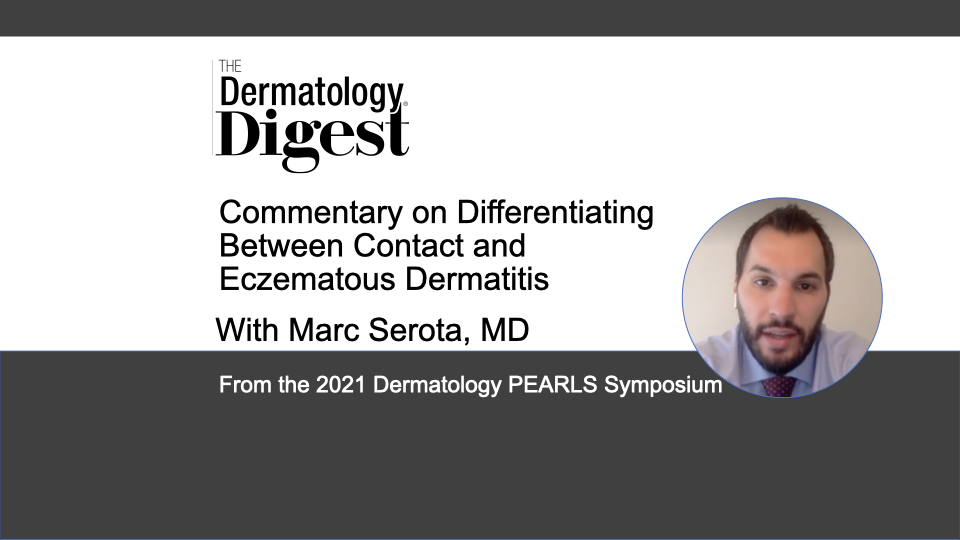Dr. Marc Serota discusses pearls for identifying and differentiating allergic contact, irritant, and other forms of dermatitis.
Marc Serota, MD, is a triple board-certified dermatologist, including allergy/immunology and pediatrics, and CEO and Founder of MD Integrations, Denver, Colorado.
“Traditionally, [differentiating between contact and eczematous dermatitis] is a very difficult thing… because the rashes in and of themselves can look very similar and those diseases are not mutually exclusive,” said Marc Serota, MD, who shared tips for distinguishing among the different forms of eczematous rashes at the 2021 Dermatology PEARLS symposium.
“Knowing some of the particular differentiating points and some of the things that you look for on exam and in the history can really help you in these visits that otherwise can sometimes be very challenging, frustrating visits,” he said.
Importantly, there are some forms of dermatitis that require underlying treatment from different medical specialties, such as those caused by nerve disorders (notalgia paresthetica)or cutaneous T cell lymphoma (CTCL).
“If you don’t identify that and just treat it as a dermatitis, we’re missing potentially a serious life-altering condition and delaying the patient presenting to care.”
Allergic vs. Irritant Contact Dermatitis
A basic differentiator of allergic vs. irritant contact dermatitis is reaction. If it’s allergic, the reaction should happen at every exposure to a particular substance, said Dr. Serota.
“If sometimes they put on the cream and they get the reaction and sometimes they don’t, that would not typically be consistent with an allergic type of response.”
Another differentiator is timing, which Dr. Serota details in our exclusive video interview.
There’s also distribution as differentiator.
“You want to see if it’s symmetric and also if it’s geometric. If something is from an external source, it should not look like something that is a naturally occurring phenomenon in your body,” said Dr. Serota.
When the dorsal aspect of the hand and/or finger webbing is affected, it’s more likely irritant dermatitis, especially if your patient does wet work, which Dr. Serota defines as “glove wearing more than 20 hours per day, and hand cleansing more than 20 times per day.”
“…there’s a number of chemical irritants in a detergent category—solvents, oxidizing agents, acid and alkalies—that can all contribute to someone’s irritant dermatitis,” he said.
Physical irritants are experienced by people who work with materials such as paper, metals, plants, fiberglass—carpenters, plumbers, electricians, landscapers. But don’t go down the allergy-identifying rabbit hole when patch testing fails, advised Dr. Serota.
“If they work in one of these industries and their hands are the primary thing, think about irritant before you start thinking about allergic contact.”
Differentiating Other Types of Dermatitis
Dr. Serota offered several pearls for identifying other, specific types of dermatitis:
Allergic contact dermatitis — think geometric distribution, symmetric distribution, history 48 to 72 hours before contact, and same reaction every time they come in contact.
Irritant dermatitis — think dorsal hands and wet work.
Dyshidrotic hand eczema — small fluid filled blisters on the fingers.
Nummular dermatitis — coin-shaped eczematous plaques that are filled in.
Atopic dermatitis — think antecubital fossa, popliteal fossa. “And use your history: Do they have other atopic conditions like allergies and asthma? Fifty percent of your eczema patients will have another atopic condition. And do they have a family history of ATD?”
Fixed drug eruption — same location every time; dusky gray-colored plaques.
CTCL — bathing suit distribution and does not respond to typical therapies.
Bullous pemphigoid — elderly patients. “They have blisters, which is easy. But if in their earlier stages, they’re just exhibiting urticarial-phase bullous pemphigoid, don’t forget if it’s an elderly patient with a new dermatitis or a new urticarial type rash, think about bullous pemphigoid and you should biopsy it.”
Scabies — think webbing of the fingers, groin, and waistline.
Notalgia paresthetica — unilateral, scapula, hyperpigmented. “And don’t forget to ask about what’s going on underneath with the nerves.”
Stasis dermatitis — bilateral lower legs, edema. “Don’t forget to ask what’s happening with the blood vessels.”
Perioral dermatitis — hugs the nasal alae around the mouth; looks like acne and eczema (little pustules).
Sebbharaic dermatitis — greasy scale in hair-bearing areas.
Urticaria — lesions that last less than 24 hours with a wheel and flare. “Dermatitis should last a lot longer than that. An individual lesion of urticaria by definition should last less than 24 hours.”

